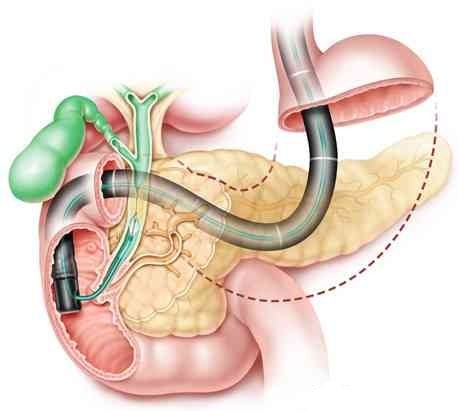 EUS引导和ERCP引导下胆道引流术对恶性胆道梗阻的疗效:前瞻性随机对照研究
背景和目的:
EUS引导和ERCP引导下胆道引流术对恶性胆道梗阻的疗效:前瞻性随机对照研究
背景和目的:当胆道恶性梗阻不能行根治性手术时,ERCP引导下胆道引流术(ERCP-BD)是一种标准的治疗方式。替代方法如经皮经肝胆管引流会显著降低患者的生活质量。超声内镜(EUS)引导下胆道引流术(EUS-BD)也已经由经验丰富的内镜医师开展。因此,本研究的目的是评估EUS-BD与ERCP-BD在恶性胆道梗阻中的疗效和安全性。
方法:我们进行前瞻性随机对照研究,共纳入30例患者。EUS-BD组和ERCP-BD组各15例。对技术性成功,操作时间,临床性成功和不良事件进行评估。
结果:30例患者均为肝外胆道恶性梗阻(19名男性,11名女性)。 27例患者为不可切除的胰腺导管腺癌,1例患者患有胆总管远端癌,2例患者有转移性恶性淋巴结肿大。 在技术成功率和临床成功率方面没有显着差异(ERCP-BD与EUS-BD分别为100%vs 93%和93%vs 100%; P =1.00,P=1.00)。 ERCP-BD组中有4名患者(31%)出现肿瘤向支架内生长导致的支架功能障碍,而EUS-BD组有2名患者有食物堵塞,2名患者有支架移位。 两组均未发生明显的手术相关不良事件。
结论:这项前瞻性随机对照研究表明,EUS-BD与ERCP-BD具有相似的安全性.EUS-BD在缓解恶性胆道梗阻方面并不优于ERCP-BD。 EUS-BD可能有较少的肿瘤向支架内生长病例,但也可能有更多的食物堵塞或支架移位病例。
Efficacy of EUS-guided and ERCP-guided biliary drainage for malignant biliary obstruction prospective randomized controlled study
JK Park, YS Woo, HN Dong et al. GASTROINTESTINAL ENDOSCOPY Volume 88, No. 2: 2018
Background and Aims: ERCP-guided biliary drainage (ERCP-BD) is a criterion standard treatment for malignant biliary obstruction when curative surgery is not an option. Alternative methods such as percutaneous transhepatic biliary drainage would significantly lower the quality of life. EUS-guided biliary drainage (EUS-BD) has been developed and performed by experienced endoscopists. Therefore, the aims of this study were to evaluate the efficacy and safety of EUS-BD compared with ERCP in malignant biliary obstruction.
Methods: The prospective randomized controlled study was conducted, and 30 patients were enrolled: 15 for each EUS-BD and ERCP-BD arms. The technical success, procedural time, clinical success, and adverse events were evaluated.
Results: Thirty patients had extrahepatic malignant biliary tract obstruction (19 men, 11 women). Twenty-seven patients had unresectable pancreatic ductal adenocarcinomas, 1 patient had distal common bile duct cancer, and 2 patients had metastatic malignant lymphadenopathy. There were no significant differences both in terms of technical success rate and clinical success rate (100% vs 93% and 93% vs 100% in ERCP-BD vs EUS-BD, respectively; P=1.00, P=1.00). Four patients (31%) had tumor ingrowth–caused stent dysfunction in the ERCP-BD group, whereas 2 patients had food impaction and 2 patients had stent migration in the EUS-BD group. No significant procedure-related adverse events occurred in either group.
Conclusions: This prospective randomized controlled study suggests that EUS-BD has similar safety to ERCP-BD.EUS-BD was not superior to ERCP-BD in terms of relief of malignant biliary obstruction. EUS-BD may have fewer cases of tumor ingrowth but may also have more cases of food impaction or stent migration.
翻译: 于廷廷 审校:张立超、侯森林 (GASTROINTESTINAL ENDOSCOPY 2018)



